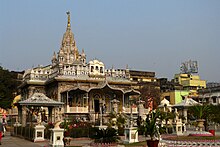
The Dilwara Temples or Delvada Temples are a group of Śvētāmbara Jain temples located about 2+1⁄2 kilometres from the Mount Abu settlement in Sirohi District, Rajasthan's only hill station. The earliest were built by Bhima I and supposedly designed or at least financed by Vastupala, Jain minister of Dholka. They date between the 11th and 16th centuries, forming some of the most famous monuments in the style of Māru-Gurjara architecture, famous for their use of a very pure white marble and intricate marble carvings. They are managed by Seth Shri Kalyanji Anandji Pedhi, Sirohi and are a pilgrimage place for Jains, and a significant general tourist attraction. The Dilwara temples are regarded as the most impressive among Jain temples in Rajasthan.

Shikharji, also known as Sammet or Sammed Shikharji, is one of the holiest pilgrimage sites for Jains, in Giridih district, Jharkhand. It is located on Parasnath hill, the highest mountain in the state of Jharkhand. It is the most important Jain Tirtha, for it is the place where twenty of the twenty-four Jain tirthankaras along with many other monks attained Moksha. It is one of the five principal pilgrimage destinations along with Girnar, Pawapuri, Champapuri, Dilwara, Palitana and Ashtapad Kailash.
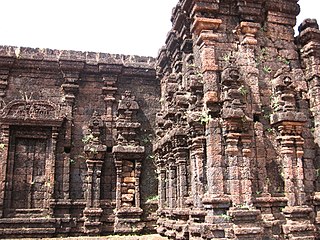
The Rajarajeshwara temple is a Shiva temple located in Taliparamba in Kannur district of Kerala State of India. The temple is regarded as one of the existing 108 ancient Shiva Temples of ancient Kerala. It also has a prominent place amongst the numerous Shiva temples in South India. It had the tallest shikhara amongst the temples of its time. The Rajarajeshwara temple has a top of about 90 tonnes. If any problem is encountered in the other temples of South India, devotees seek a solution in this temple through a prashnam, a traditional method of astrological decision-making. The prashnam is conducted on a peedha outside the temple.

Sri Digambar Jain Lal Mandir is the oldest and best-known Jain temple in Delhi, India. It is directly across from the Red Fort in the historical Chandni Chowk area.
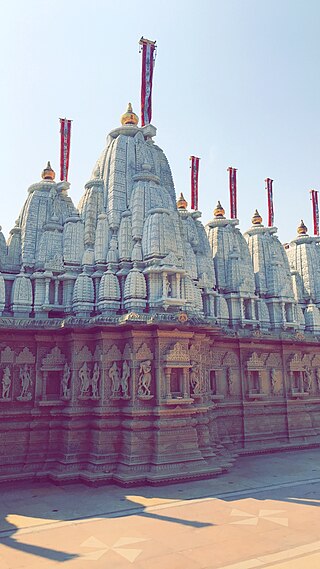
Shankheshwar is a town in the Patan district of Gujarat state of India. It is an important place of pilgrimage for the followers of Jainism.
Jain rituals play an everyday part in Jainism. Rituals take place daily or more often. Rituals include obligations followed by Jains and various forms of idol worship.

A Dādābāḍī is a type of shrine, usually located near a Jain temple, and dedicated to one of the four Dādā Gurus revered by the Kharatara Gaccha sect of the Śvetāmbara Jains. The most notable shrines are in Ajmer, Malpura and Mehrauli. The four Dādā Gurus are Jinadatta Sūri, Jinachandra Sūri Maṇidhārī, Jinakuśala Sūri and Jinachandra Sūri II.

The Shankheshwar Jain Temple is located in the center of Shankheshwar town of Patan district, Gujarat, India. The temple is dedicated to Parshwanath and is an important place of pilgrimage for the followers of Jainism.
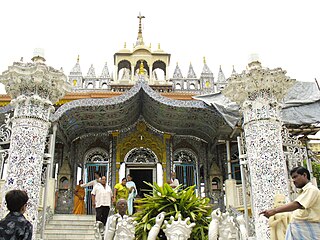
Shrimal (Srimal) Jain is an ancient Jain and Hindu community originally from Rajasthan, Shrimal or Bhinmal town in southern Rajasthan. They were traditionally wealthy merchants and money lenders and were prominent at the court of Rajput kings as treasurers and ministers, holding the titles of Dewan or Durbari. This caste is claimed to descend from the Goddess Lakshmi and their descendants are well known for business acumen and are in possession of Havelis and mansions given to them as gifts from kings for their service as royal treasurers, ministers, courtiers and advisors. The Shrimal (Srimal) Jain are thought to be the highest gotra in the Oswal merchant and minister caste that is found primarily in the north of India.

Naya Mandir is a historic Jain temple in Old Delhi in India, in the Dharampura locality allocated to the Jain community by Aurangzeb.
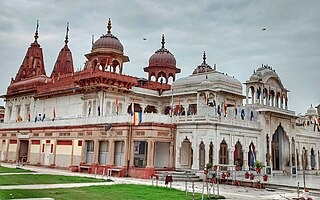
Shri Mahavir Ji is an important and prominent Jain pilgrimage site situated in Shri Mahaveerji town in Hindaun Block, Karauli district in Rajasthan. Given the importance of the religious place, the Indian Railways has specifically developed a railway station under West Central Railway zone by the name of Shri Mahaveerji railway station which is 10 minutes drive from the temple and temple authorities have arranged for regular buses from the station to the temple. The temple is visited by millions of Jain and Hindu devotees every year.

The Ajmer Jain temple, also known as Soniji Ki Nasiyan, is a Jain temple known for its architecture. It was built in the late nineteenth century. The main chamber, known as the Swarna Nagari "City of Gold", has several gold-plated wooden figures, depicting several figures in the Jain religion. This golden chamber of the temple uses 1,000 kg of gold to carve out a depiction of Ayodhya.
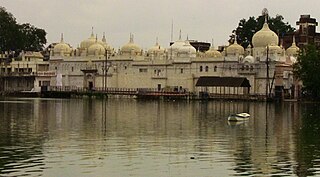
Bara Mandir is a historic Jain temple in Jabalpur, India, right on the edge of Hanumantal, once the main center of Jabalpur.
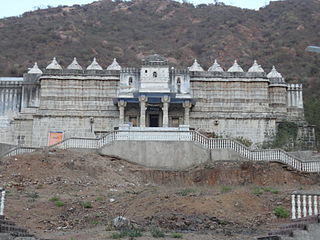
Mirpur Jain Temple is a site of Śvetāmbara Jain pilgrimage situated in Mirpur, a fortified village in the Sirohi district of Rajasthan, India. The village has four Jain temples.
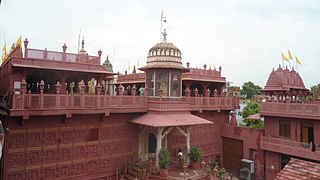
Shri Digamber Jain Atishya Kshetra Mandir, Sanghiji is an ancient Jain Temple in Sanganer, Rajasthan made of red stone. The ancient Shri Digamber Jain temple of Sanganer is 16 km from Jaipur.

Navagraha Jain Temple or Navagraha Teertha or Navagraha Tirtha is situated at Varur near Hubli, Karnataka. Navagraha Teertha is one of the major pilgrim spots for the Jain community in India. The temple features a 61-foot (19 m) tall monolithic idol of the Shri 1008 Bhagavan Parshvanatha and the smaller statues of the other eight Jain teerthankaras. The statue is the tallest statue of the Jain deity Parshvanatha in India and weighs 185 tons. The statue stands on a 48-foot (15 m) high pedestal(109-foot total).

The Gori Temple is a Jain temple in Nagarparkar. It's located 14 miles northwest of the Viravah Temple. It was built in 1375-1376 CE. The temple was exclusively allocated to the 23rd Jain Tirthankar Lord Parshwanath. This temple along with Jain temples of Nagarparkar were inscribed on the tentative list for UNESCO World Heritage status in 2016 as the Nagarparkar Cultural Landscape.
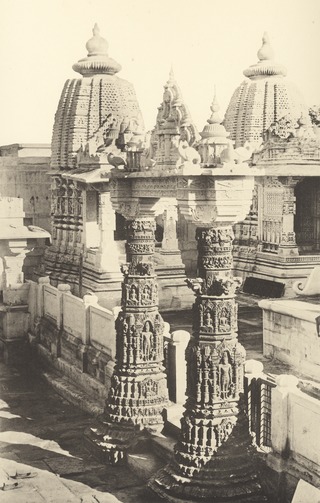
The Mahavira Jain temple is built in Osian of Jodhpur District, Rajasthan. The temple is an important pilgrimage of the Oswal Jain community. This temple is the oldest surviving Jain temple in Western India and was built in 457 BC.

Vidisha is considered to be Puranakshetras Jain tirtha. The Jain temples are located in Vidisha district in state of Madhya Pradesh, India. According to Jain belief, Vidisha is the birthplace of Shitalanatha, the tenth tirthankar. Here the first 108 feet elevated temple with all Tirthankaras with Shitalanatha as the principal deity is under construction.
